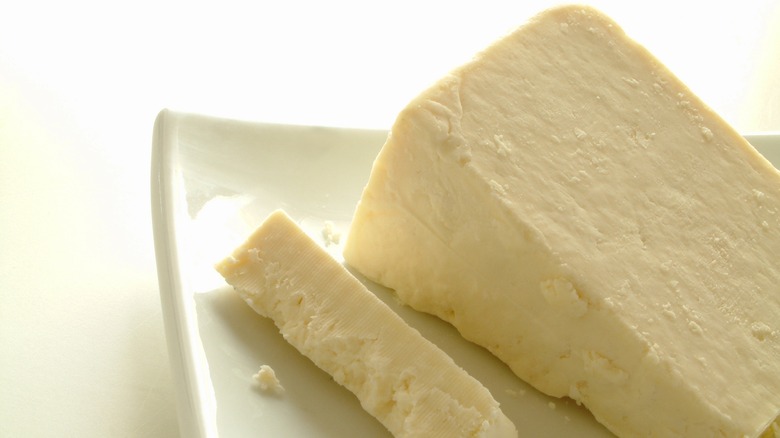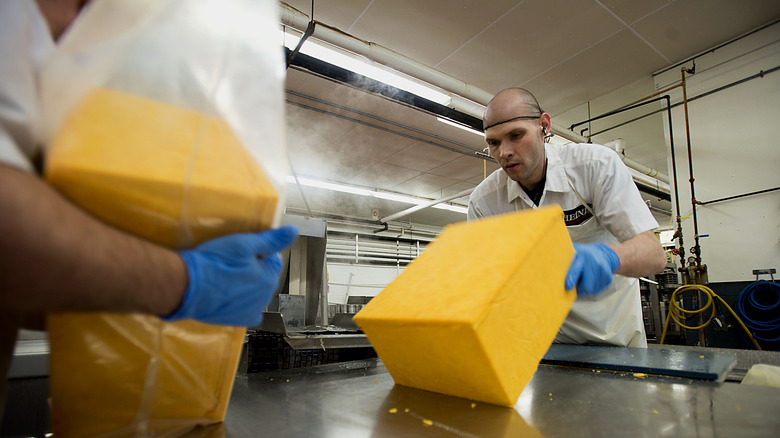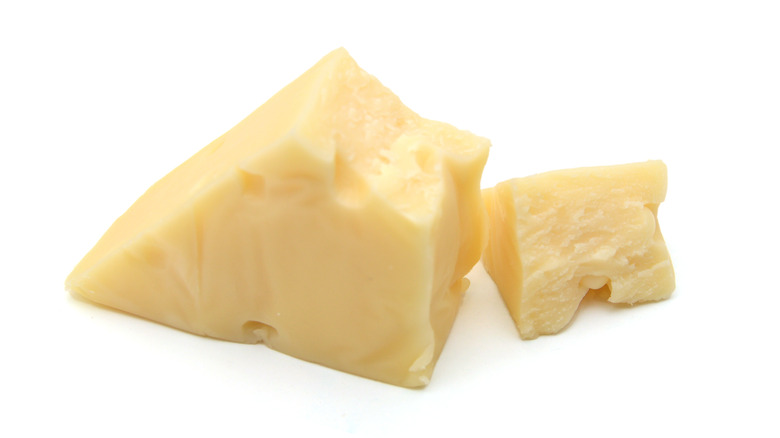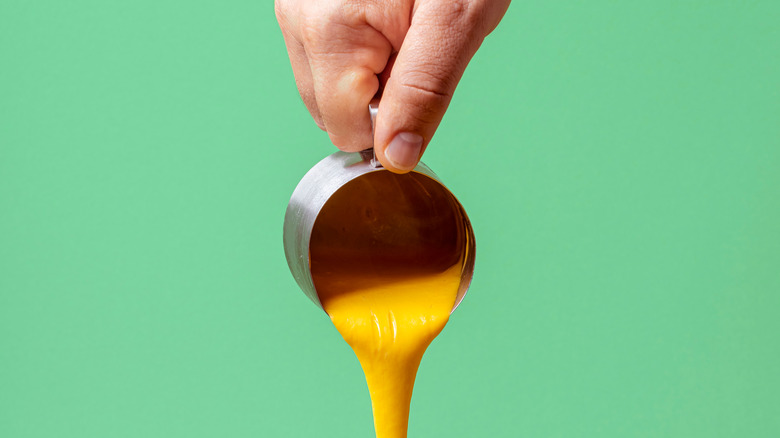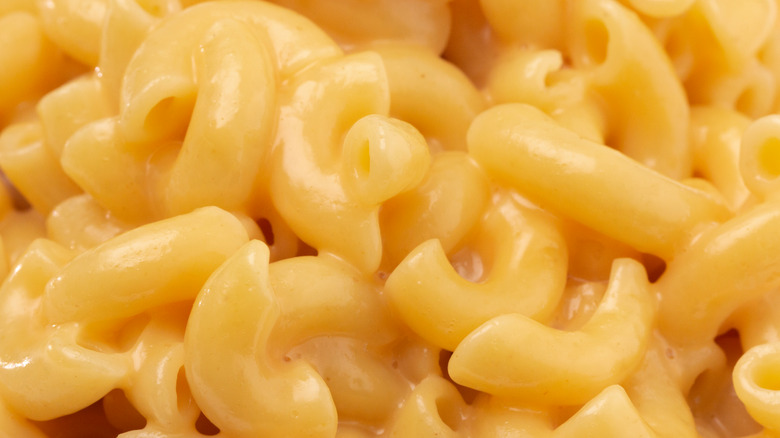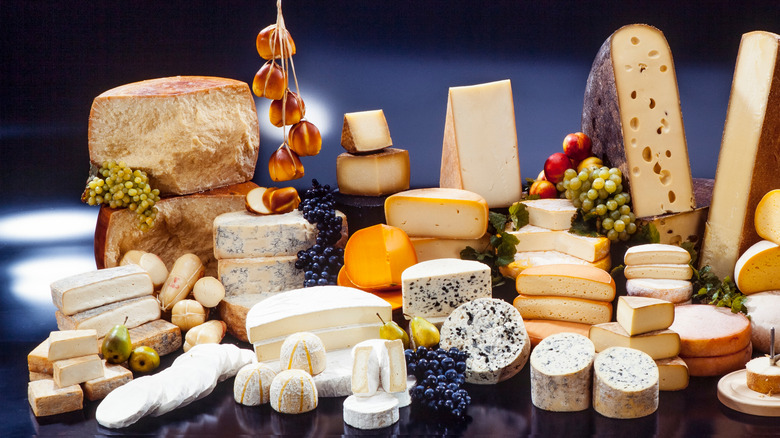Everything You Need To Know About Cheddar Cheese
In the kingdom of cheeses, cheddar falls far below the heights of royalty afforded to stilton and époisses, occupying the position of the everyday person. It comes with different flavors and different colors. It is the cheese you find in the supermarket. It is the cheese you use when you want something fancier than American. The Boston Globe tells us that when scientists want to study cheese, they almost always turn to cheddar. Cheddar is so cheese that Goldfish are made with artificial cheddar. It welcomes all.
Cheddar's ubiquity makes it hard to pin down though. What is cheddar? From what corner of the world did it emerge to grace our shelves? Why is it so popular? To these questions we will now turn ourselves. This is everything you need to know about cheddar cheese.
Cheddar originally came from Cheddar, a village in the English county Somerset — hence the name. According to The Guardian, ordinary village life led to the accidental discovery of the cheese. Sometime in the 12th century, a milkmaid had left a pail of milk in one of the caves of Cheddar Gorge. By the time she retrieved it, the milk had solidified somewhat. While the following eight centuries may have hyperbolized the event, The Independent explains that the caves do in fact help with cheese maturation. The humidity and temperatures stay at a perfect constant for the process. So, the people of the village began to store their cheese in the caves.
Cheddar came from Cheddar
The popularity of this cheese happened almost immediately after the discovery, The Independent continues. In 1172, King Henry II purchased 10,240 pounds worth of cheddar cheese. His son John and later monarch Charles I both bought cheddar regularly, transforming it from a parochial oddity to a national staple.
The cheddar many know today, however, is due to the immigration to the United States and, as Gordon Edgar told Splendid Table, the creation of the first cheddar cheese factory in upstate New York. However, Edgar laments that the goal of every innovation involved with the creation of cheddar since has been to make it as efficient as possible. In other words, the end goal of cheddar was the cheddar cheese flavoring substances we find between Ritz crackers. Flavor was lost for widespread appeal.
At a glance, the term "cheddar" isn't very helpful. It doesn't have to come from Cheddar in the way champagne has to come from the Champagne district. It can be white or yellow, sharp or mild. In short, the word "cheddar" has very little to do with the cheese.
The Courtyard Dairy goes further, noting that a 1966 Codex for Trading Standards states that all cheddar cheeses must be firm, with less than 39 percent moisture. True, there is a "cheddaring process," in which cut curds are stacked into blocks to transform the texture from crumbly lumps to an elastic texture by draining the cheese of whey. But there is no official body regulating this and some Cheddar cheese makers don't follow the technique.
Understanding the sharp chart
This, the PH Cheese suggests, could be due to the individualistic way cheddar cheese was once made. Each farm would produce its own cheddar, so a strict definition could not be retrospectively imposed. You can see this in the U.S. regulations, which call cheddar "any cheese with a moisture content of up to 39% and at least 50% fat in dry matter." This would explain why cheddar has overtaken the idea of generic cheese in every supermarket.
The looseness of the cheddar category might also explain why cheddar is the only cheese to require further descriptors like sharp and mild. After all, feta, for example, is a specific cheese that has a specific taste. Cheddar, however, can vary in flavor.
Talking to Business Insider, Dr. Michael Tunick, author of "The Science of Cheese," explains that as the cheese ages, the bacteria used to produce the cheese from the milk breaks down the protein and fat. These make the resulting cheese less creamy, but more flavorful. In other words, it becomes less mild and more sharp.
However, as John Spencer, managing director of the Cheddar Gorge Cheese Company, says in an explanation shared by ChowHound, the flavoring of cheddar is not an exact science. The end product relies on the milk and climate as much as the ageing process. Still, if you see that a cheese is advertised as sharp, you can know that it will be relatively older and smack you with a relatively more pungent flavor.
The difference between white and yellow cheddar
The color you imagine cheddar is one of those culturally instilled images that you don't think about but hold onto when someone else disagrees. However, despite the closeness with which we might hold it, the color doesn't actually make any difference to the cheddar itself. If you buy mild orange cheddar or mild white cheddar, the differences will be negligible when compared to mild vs sharp.
The reason that cheddar colors differ so little is that orange cheddar is just dyed white cheddar. Josh Windsor, assistant caves manager at Murray's Cheese, explained to HuffPost that many cheesemakers add annatto, which is a food coloring derived from seeds found in South America, to cheese in order to give the product a uniform appearance throughout the year. Otherwise, the color of cheese will vary from very white to more yellow as the cows change from consuming hay in the winter to grazing on grass in the spring. A second bonus for altering the color of cheddar is that for many, the vibrant orange of dyed cheese offers an appearance of bounty and decadence. However, such differences are entirely visual.
How healthy is cheddar
At this point, you may want to start nibbling on a chunk or even a block. Cheddar is delicious. Looking at the information in the United States Department of Agriculture's database, one finds that cheddar is neither a health food nor the worst thing you can eat. One gram provides 200 milligrams of calcium and 7 grams of protein. However, it is a dairy product, so those benefits will come with 120 calories per gram, 10 grams of fat, 6 grams of saturated fat, and 30 milligrams of cholesterol.
That dour note is balanced by findings shared by Business Insider in 2018. In their report, the latest study to discover the health benefits of cheese found that overweight, older adults had lower cholesterol by eating full-fatted cheddar than their lower-fat consuming peers. "We need to stop thinking about foods in terms of their fat and their saturated fat content, and thinking about them as a whole food," Emma Feeney, who studies human nutrition and metabolism at University College Dublin, explained. However, this means you should enjoy cheddar in moderation, not in excess. The dairy fats of cheese won't harm you in small amounts, but you can certainly overdo it.
Cheeses are pretty versatile and cheddar is pretty versatile for a cheese. You can eat it straight, biting the block. You can cut a chunk off and carry it to your mouth with a cracker. You can use it in a salad or as an ingredient for a cheesy dish like mac and cheese or cheesy mashed potatoes.
How to cook with cheddar
It is very hard to go wrong when it comes to cheddar. In fact, the BBC's only real advice on the matter is that if you are using cheddar to cook, you should go for the sharper varieties. If you use mild cheddar, the flavor will most likely disappear in the cooking, leaving you without any kind of cheesy goodness. A strong flavor, however, would survive.
The grocery store will probably stock a solid, stolid middle grade cheddar. They could have the cheese in blocks or shredded in bags, though The Kitchn recommends buying cheddar by the block. This advice can go for any cheese as to preserve the shredded cheese, extra ingredients are added, including the much reported cellulose, sometimes sourced from sawdust.
If you really want to have truly good cheddar, however, you should visit either a supermarket with a cheese store set up or a cheese store itself. They generally have a wider, more artisanal array of cheddars on hand and, as the Cheese Grotto notes, there will be an informed helper on hand to answer any questions about the differences between individual cheddars. And cheddars can come with vast differences.
Substitutes for cheddar
In the end, however, you may have grown sick of cheddar. So, you want to replace it with another type of cheese. Fair enough. Even though cheddar is not something that can be easily substituted, it is not such a unique food. Cheese, at a certain point, is cheese.
There are at least three ways you can go. You can replace it with another type of cheese. Or, if you are hankering after the cheddar flavor, you can replace it with American cheese. Although Diffen does note that American cheese is an artificial product, you can swap it with cheddar.
If you want to introduce a new cheese, you have a huge array of choices. Annie Andre, for example, created a list of 10 cheeses she used after moving to France. Apparently, the French are not very fond of cheddar. These included Chantal, Aged Gouda, and Emmental. She writes that none taste like cheddar, but they all serve well enough in recipes that call for it. The third option is you can try a different type of cheddar.
